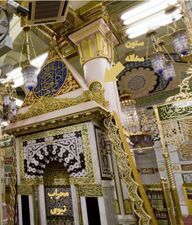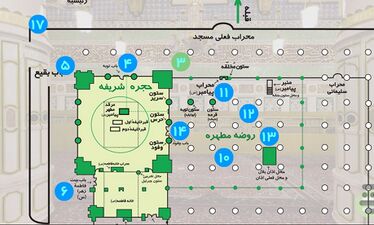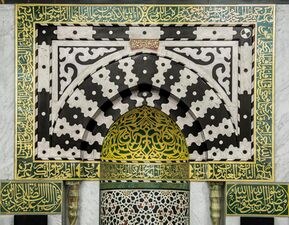The Prophet's Mihrab: Difference between revisions
Pourghorbani (talk | contribs) No edit summary |
No edit summary |
||
| (9 intermediate revisions by 2 users not shown) | |||
| Line 1: | Line 1: | ||
'''Prophet's | {{Building | ||
| title = the Prophet's Mihrab | |||
| image = محراب پیامبر.jpg | |||
| image size = | |||
| image link = | |||
| image description = | |||
| other names = Mihrab al-Nabi, Mihrab Rasul Allah | |||
| place = [[Al-Masjid al-Nabawi]] | |||
| usage = | |||
| religious affiliation = | |||
| beliefs = | |||
| rituals = | |||
| rulings = | |||
| pilgrims = | |||
| visitors = | |||
| time of construction = | |||
| founder = | |||
| events = | |||
| reconstructions = In the time of al-Walid b. 'Abd al-Malik and Mamaluks | |||
| reconstructors = | |||
| missing parts = | |||
| historical features = | |||
| trustee = | |||
| space = | |||
| length = | |||
| width = | |||
| height = | |||
| status = | |||
| capacity = | |||
| facilities = | |||
| parts = | |||
| architect = | |||
| style = | |||
| properties = | |||
| domes = | |||
| minarets = | |||
| doors = | |||
| porticos = | |||
| courts = | |||
| verandas = | |||
| affiliated entity = | |||
| maintaining entity = | |||
| administrator = | |||
| imam of prayer = | |||
| subsidiary entities = | |||
| registered in = | |||
| registration no. = | |||
| registration date = | |||
| website = | |||
| latitude = | |||
| longitude = | |||
| map description = | |||
}} | |||
'''The Prophet's Mihrab''' (Arabic: {{ia|محراب النبي}}) is the place where [[Prophet Muhammad(a)]] used to pray, which is located in the [[al-Masjid al-Nabawi]] between the [[Prophet's pulpit]] and his grave. During the time of the Prophet (s), there was nothing in the form of a mihrab, until later during the development of the al-Masjid al-Nabawi during the period of al-Walid b. 'Abd al-Malik, a mihrab was built in the place of his prayer. Qaitbay, the king of Egypt (9th/15th century) rebuilt the hollow-shaped mihrab by renewing the mosque. This mihrab was decorated during the era of Ottoman rule and is still located in al-Masjid al-Nabawi. | |||
==History== | ==History== | ||
During the time of | During the time of [[Prophet Muhammad(a)]], in the place of [[al-Masjid al-Nabaw]] where he prayed, there was no mihrab in any form<ref>Ṣāliḥ Lumaʿī, ''al-Madīnat al-munawwara'', p. 59. </ref> and the place of prayer of the Prophet (s), had no sign except that it was next to the [[al-Mukhallaqa pillar]].<ref>ʿAṭṭār, ''al-Taʿrīf bi-tārīkh wa maʿālim al-Masjid al-Nabawī al-sharīf'', p. 162. </ref> This was the first time in the development of al-Masjid al-Nabawi, during the period of al-Walid b. 'Abd al-Malik (r. 86/705 -96/714-5), that a mihrab was built at the place of the Prophet's prayer.<ref>Sayyid al-Wakīl, ''al-Masjid al-Nabawī ʿibar tārīkh'', p. 128; Jaʿfarīyān, ''Āthār-i Islāmī-yi Makka wa Madīna'', p. 260. </ref> | ||
===During the | ===During the Mamluk Period=== | ||
Although historical sources do not have any reports about the reconstruction of the | Although historical sources do not have any reports about the reconstruction of the mihrab during the period of [[Baybars al-Bunduqdari]] (r. 658/1259-60 - 676/1277-8), the fourth [[Mamaluk]] king, some researchers, by examining historical evidence, believe that the first hollow-shaped mihrab (carved into the wall) in the reconstructions of the Baybars period was made in the place that [[Prophet Muhammad(a)]] prayed; Because the reports of the sources before this date did not mention the existence of a hollow-shaped mihrab in the place of the Prophet's prayer.<ref>Al-Shahrī, ''ʿImārat al-Masjid al-Nabawī'', p. 227. </ref> | ||
In the reconstruction of [[Masjid al- | In the reconstruction of [[al-Masjid al-Nabawi]] during the period of Qaitbay, the Mamluk sultan, in 888/1483-4 after the fire in al-Masjid al-Nabawi, the mihrab was rebuilt in the place of the Prophet's prayer, and in the same period, it was decorated with marble and verses from the Quran were engraved on it.<ref>Al-Shahrī, ''ʿImārat al-Masjid al-Nabawī'', p. 342. </ref> | ||
===In the Ottoman | ===In the Ottoman Period=== | ||
In the reconstruction of [[Masjid al- | In the reconstruction of [[al-Masjid al-Nabawi]] during the reign of [[king Abd al-Majid I]], the Prophet's Mihrab, which was left over from the time of [[Qaitbay]], was gilded. Also, during this time, ʿAbd Allah al-Zuhdi, a Turkish calligrapher, engraved verses of the Quran, texts and poems on the mihrab.<ref>Ṣāliḥ Lumaʿī, ''al-Madīnat al-munawwara'', p. 96. </ref> In the Saudi period, the same mihrab of the Qaitbay period remained.<ref>Anṣārī, ''ʿImāra wa tawsiʿat al-Masjid al-Nabawī'', p. 170. </ref> | ||
== | ==Location== | ||
The Prophet's | The Prophet's Mihrab was built in the place of [[al-Masjid al-Nabawi]] where [[Prophet Muhammad(s)]] prayed.<ref>Sayyid al-Wakīl, ''al-Masjid al-Nabawī ʿibar tārīkh'', p. 128; Jaʿfarīyān, ''Āthār-i Islāmī-yi Makka wa Madīna'', p. 260. </ref> This mihrab is located next to the [[al-Mukhallaqa pillar]]<ref>Sayyid al-Wakīl, ''al-Masjid al-Nabawī ʿibar tārīkh'', p. 163. </ref> and in the distance between the pulpit of the Prophet (a) and his grave ([[al-Rawḍa al-Sharifa]]).<ref>Sayyid al-Wakīl, ''al-Masjid al-Nabawī ʿibar tārīkh'', p. 163. </ref> Researchers are of the opinion that this place is the place where the Prophet(s) prayed.<ref>Sayyid al-Wakīl, ''al-Masjid al-Nabawī ʿibar tārīkh'', p. 128; Jaʿfarīyān, ''Āthār-i Islāmī-yi Makka wa Madīna'', p. 260. </ref> | ||
The | |||
The mihrab is placed in such a way that the one who prostrates in it places his forehead on the Prophet's sitting place, not his prostration place.<ref>Sayyid al-Wakīl, ''al-Masjid al-Nabawī ʿibar tārīkh'', p. 163. </ref> The Prophet's prostration place is placed under the mihrab.<ref>ʿAṭṭār, ''al-Taʿrīf bi-tārīkh wa maʿālim al-Masjid al-Nabawī al-sharīf'', p. 164. </ref> | |||
==Gallery== | ==Gallery== | ||
<gallery mode="packed" heights="150px"> | <gallery mode="packed" heights="150px"> | ||
file:محراب النبی.jpg|The | file:محراب النبی.jpg|The the Prophet's Mihrab is connected to the al-Mukhallaqa pillar. | ||
file:نقشه مسجد النبی، محراب پیامبر.jpg|The location of the Prophet's | file:نقشه مسجد النبی، محراب پیامبر.jpg|The location of the the Prophet's Mihrab on the map of [[al-Masjid al-Nabawi]]. | ||
file:محراب پیامبر۲.jpg|Decorations of the | file:محراب پیامبر۲.jpg|Decorations of the the Prophet's Mihrab with marble and gilding and verses from the Quran are written on it. | ||
</gallery> | </gallery> | ||
==Notes== | ==Notes== | ||
{{Notes}} | {{Notes}} | ||
==References== | ==References== | ||
{{References}} | {{References}} | ||
* | * Anṣārī, Nājī Muḥammad Ḥasan ʿAbd al-Qādir al-. ''ʿImāra wa tawsiʿat al-Masjid al-Nabawī al-sharīf ʿibar tārīkh. [n. p], Nādī l-Madīna al-Munawwara al-Adabī, 1996. | ||
*Hazzaʿ al-Shahrī, Muḥammad . | * Hazzaʿ al-Shahrī, Muḥammad al-. ''ʿImārat al-Masjid al-Nabawī munz inshāʾihī ḥattā nihāyat al-ʿaṣr al-Mamlūkī''. Cairo: Maktabat al-Qāhira li-l-kutub, 2001. | ||
*Hazzaʿ al-Shahrī, Muḥammad .Al- | * Hazzaʿ al-Shahrī, Muḥammad al-. ''Al-Masjid al-nabawī al-sharīf fī al-ʿaṣr al-ʿUthmānī''. Cairo: Dār al- Qāhira, 2003. | ||
* | * Jaʿfarīyān, Rasūl. ''Āthār-i Islāmī-yi Makka wa Madīna''. Tehran: Mashʿar, 1391Sh | ||
* | * Ṣāliḥ Lumaʿī, Muṣṭafā. ''Al-Madīnat al-munawwara, taṭawwurihā l-ʿumrānī wa turāthihā l-miʿmārī''. Beirut: Dār al-Nihḍa al-ʿArabīyya, 1981. | ||
*Sayyid al-Wakīl, Muḥammad al- .Al- | * Sayyid al-Wakīl, Muḥammad al-. ''Al-Masjid al-Nabawī ʿibar tārīkh''. [n. p], Dār al-Mujtamaʿ li-l-Nashr wa l-Tawziʿ, 1988. | ||
*Sayyid Ḍīyāʾ b. Muḥammad b. Maqbūl | * ʿAṭṭār, al-Sayyid Ḍīyāʾ b. Muḥammad b. Maqbūl al-. ''Al-Taʿrīf bi-tārīkh wa maʿālim al-Masjid al-Nabawī al-sharīf''. Jeddah: Kunūz al-Maʿrifa, 1432AH. | ||
{{end}} | {{end}} | ||
[[fa:محراب پیامبر]] | [[fa:محراب پیامبر]] | ||
[[ar:محراب النبي]] | [[ar:محراب النبي]] | ||
[[category: Mihrabs of al-Masjid al-Nabawi]] | |||
Latest revision as of 14:30, 29 November 2023
 | |
| General Information | |
|---|---|
| Other Names | Mihrab al-Nabi, Mihrab Rasul Allah |
| Place | Al-Masjid al-Nabawi |
| History | |
| Reconstructions | In the time of al-Walid b. 'Abd al-Malik and Mamaluks |
The Prophet's Mihrab (Arabic: محراب النبي) is the place where Prophet Muhammad(a) used to pray, which is located in the al-Masjid al-Nabawi between the Prophet's pulpit and his grave. During the time of the Prophet (s), there was nothing in the form of a mihrab, until later during the development of the al-Masjid al-Nabawi during the period of al-Walid b. 'Abd al-Malik, a mihrab was built in the place of his prayer. Qaitbay, the king of Egypt (9th/15th century) rebuilt the hollow-shaped mihrab by renewing the mosque. This mihrab was decorated during the era of Ottoman rule and is still located in al-Masjid al-Nabawi.
History
During the time of Prophet Muhammad(a), in the place of al-Masjid al-Nabaw where he prayed, there was no mihrab in any form[1] and the place of prayer of the Prophet (s), had no sign except that it was next to the al-Mukhallaqa pillar.[2] This was the first time in the development of al-Masjid al-Nabawi, during the period of al-Walid b. 'Abd al-Malik (r. 86/705 -96/714-5), that a mihrab was built at the place of the Prophet's prayer.[3]
During the Mamluk Period
Although historical sources do not have any reports about the reconstruction of the mihrab during the period of Baybars al-Bunduqdari (r. 658/1259-60 - 676/1277-8), the fourth Mamaluk king, some researchers, by examining historical evidence, believe that the first hollow-shaped mihrab (carved into the wall) in the reconstructions of the Baybars period was made in the place that Prophet Muhammad(a) prayed; Because the reports of the sources before this date did not mention the existence of a hollow-shaped mihrab in the place of the Prophet's prayer.[4] In the reconstruction of al-Masjid al-Nabawi during the period of Qaitbay, the Mamluk sultan, in 888/1483-4 after the fire in al-Masjid al-Nabawi, the mihrab was rebuilt in the place of the Prophet's prayer, and in the same period, it was decorated with marble and verses from the Quran were engraved on it.[5]
In the Ottoman Period
In the reconstruction of al-Masjid al-Nabawi during the reign of king Abd al-Majid I, the Prophet's Mihrab, which was left over from the time of Qaitbay, was gilded. Also, during this time, ʿAbd Allah al-Zuhdi, a Turkish calligrapher, engraved verses of the Quran, texts and poems on the mihrab.[6] In the Saudi period, the same mihrab of the Qaitbay period remained.[7]
Location
The Prophet's Mihrab was built in the place of al-Masjid al-Nabawi where Prophet Muhammad(s) prayed.[8] This mihrab is located next to the al-Mukhallaqa pillar[9] and in the distance between the pulpit of the Prophet (a) and his grave (al-Rawḍa al-Sharifa).[10] Researchers are of the opinion that this place is the place where the Prophet(s) prayed.[11]
The mihrab is placed in such a way that the one who prostrates in it places his forehead on the Prophet's sitting place, not his prostration place.[12] The Prophet's prostration place is placed under the mihrab.[13]
Gallery
-
The the Prophet's Mihrab is connected to the al-Mukhallaqa pillar.
-
The location of the the Prophet's Mihrab on the map of al-Masjid al-Nabawi.
-
Decorations of the the Prophet's Mihrab with marble and gilding and verses from the Quran are written on it.
Notes
- ↑ Ṣāliḥ Lumaʿī, al-Madīnat al-munawwara, p. 59.
- ↑ ʿAṭṭār, al-Taʿrīf bi-tārīkh wa maʿālim al-Masjid al-Nabawī al-sharīf, p. 162.
- ↑ Sayyid al-Wakīl, al-Masjid al-Nabawī ʿibar tārīkh, p. 128; Jaʿfarīyān, Āthār-i Islāmī-yi Makka wa Madīna, p. 260.
- ↑ Al-Shahrī, ʿImārat al-Masjid al-Nabawī, p. 227.
- ↑ Al-Shahrī, ʿImārat al-Masjid al-Nabawī, p. 342.
- ↑ Ṣāliḥ Lumaʿī, al-Madīnat al-munawwara, p. 96.
- ↑ Anṣārī, ʿImāra wa tawsiʿat al-Masjid al-Nabawī, p. 170.
- ↑ Sayyid al-Wakīl, al-Masjid al-Nabawī ʿibar tārīkh, p. 128; Jaʿfarīyān, Āthār-i Islāmī-yi Makka wa Madīna, p. 260.
- ↑ Sayyid al-Wakīl, al-Masjid al-Nabawī ʿibar tārīkh, p. 163.
- ↑ Sayyid al-Wakīl, al-Masjid al-Nabawī ʿibar tārīkh, p. 163.
- ↑ Sayyid al-Wakīl, al-Masjid al-Nabawī ʿibar tārīkh, p. 128; Jaʿfarīyān, Āthār-i Islāmī-yi Makka wa Madīna, p. 260.
- ↑ Sayyid al-Wakīl, al-Masjid al-Nabawī ʿibar tārīkh, p. 163.
- ↑ ʿAṭṭār, al-Taʿrīf bi-tārīkh wa maʿālim al-Masjid al-Nabawī al-sharīf, p. 164.
References
- Anṣārī, Nājī Muḥammad Ḥasan ʿAbd al-Qādir al-. ʿImāra wa tawsiʿat al-Masjid al-Nabawī al-sharīf ʿibar tārīkh. [n. p], Nādī l-Madīna al-Munawwara al-Adabī, 1996.
- Hazzaʿ al-Shahrī, Muḥammad al-. ʿImārat al-Masjid al-Nabawī munz inshāʾihī ḥattā nihāyat al-ʿaṣr al-Mamlūkī. Cairo: Maktabat al-Qāhira li-l-kutub, 2001.
- Hazzaʿ al-Shahrī, Muḥammad al-. Al-Masjid al-nabawī al-sharīf fī al-ʿaṣr al-ʿUthmānī. Cairo: Dār al- Qāhira, 2003.
- Jaʿfarīyān, Rasūl. Āthār-i Islāmī-yi Makka wa Madīna. Tehran: Mashʿar, 1391Sh
- Ṣāliḥ Lumaʿī, Muṣṭafā. Al-Madīnat al-munawwara, taṭawwurihā l-ʿumrānī wa turāthihā l-miʿmārī. Beirut: Dār al-Nihḍa al-ʿArabīyya, 1981.
- Sayyid al-Wakīl, Muḥammad al-. Al-Masjid al-Nabawī ʿibar tārīkh. [n. p], Dār al-Mujtamaʿ li-l-Nashr wa l-Tawziʿ, 1988.
- ʿAṭṭār, al-Sayyid Ḍīyāʾ b. Muḥammad b. Maqbūl al-. Al-Taʿrīf bi-tārīkh wa maʿālim al-Masjid al-Nabawī al-sharīf. Jeddah: Kunūz al-Maʿrifa, 1432AH.


